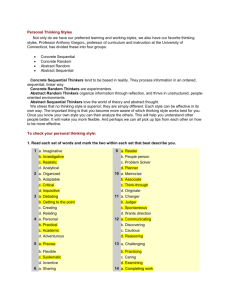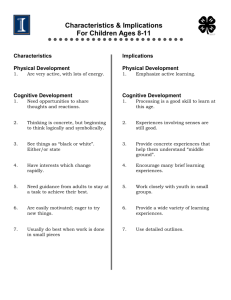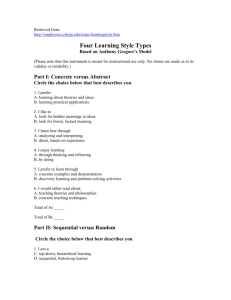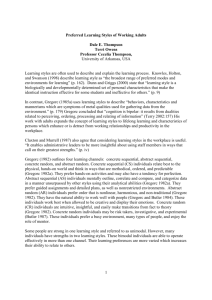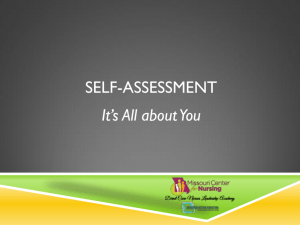Utilizing Personality
advertisement
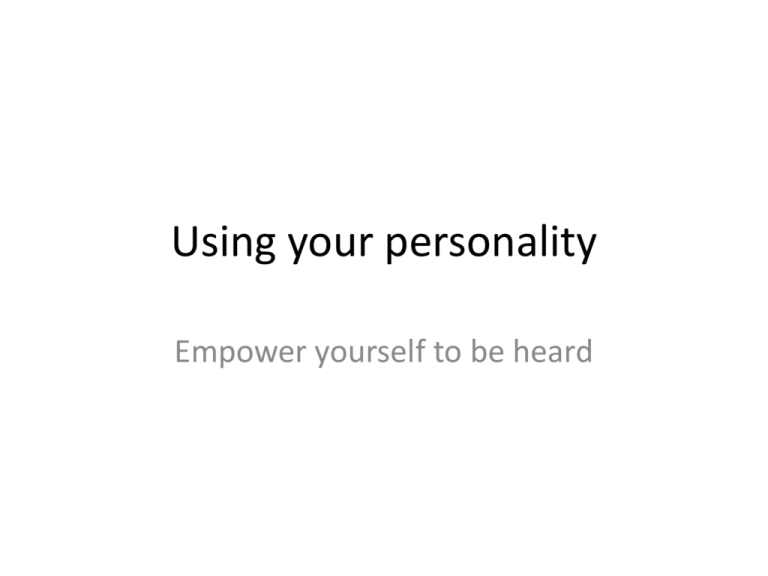
Using your personality Empower yourself to be heard Taking the Instrument 1. REFERENCE POINT. You must assess the relative value of the words in each group using your SELF as a reference point; that is, who you are deep down, NOT who you are at home, at work, at school or who you would lie to be or feel you ought to be. The ‘REAL YOU’ must be the REFERENCE POINT. 2. WORDS. The words used in the Gregorc Style Delineator matrix are not parallel in construction nor are they all adjectives or all nouns. This was done on purpose. Just read to the words as they are presented 3. RANK. Rank in order the ten sets of four words. Put a 4 in the space above the word in each set which is the best and most powerful descriptor of your SELF. Put a 3 to the word which is the next most like you, a 2 to the next, and a 1 to the word which is least descriptive of your self. Each word in a set must have a ranking of 4, 3, 2, or 1. No two words in a set can have the same rank. Taking the Instrument • 4. REACT. To rank the words in a set, react to your first impressions. There are no right or wrong answers. The real, deep-down you is best revealed through a first impression. Go with it. Analyzing each group will obscure the qualities of SELF sought by the Delineator. • 5. PROCEED. Continue to rank all ten vertical columns or words, one set at a time. • 6. TIME. Recommended time for word ranking is 4 minutes. • 7. SCORING. To score, first add the numbers across. Then add the numbers down. Instrument Used • There are many different personality instruments in use • I chose to use the Gregorc Style Delineator – Developed by Dr. Anthony Gregorc – Similar to Kolb’s and Jung’s work • Is this “who I am?” – no – just one piece of a multifaceted puzzle Example The Instrument • Two Mediation Styles – Perception and Ordering • Perception – Perceptual abilities are how you grasp information – Abstract and Concrete • Ordering – The ways in which you authoritatively arrange, synthesize reference and dispose information. – Sequence and Randomness The Instrument • Abstractness – Grasp, conceive, and mentally visualize data through the faculty of reason and to emotionally and intuitively register and deal with inner and subjective experiences. You can apprehend and perceive that which is invisible and formless to physical senses. • Concreteness – Grasp and mentally register data through the direct use of the physical senses. You can apprehend that which is visible in the concrete physical world through your physical senses. The Instrument • Sequence – You grasp and organize information in a linear, step-by-step, methodical, predetermined order. – Information is assembled by gathering and linking elements of data and piecing them together in a chain-like fashion. – Naturally sequence, arrange and categorize discrete pieces of information. – Express yourself in a precise, progressive and logically systematic manner. The Instrument • Randomness – You grasp information in a nonlinear, galloping, leaping and multifarious manner. – Large chunks of data can be imprinted on your mind in a fraction of a second. – Information is also held in abeyance and, at any given time, each chunk has equal opportunity of receiving your attention. This may not adhere to any prior or previously agreed upon arrangement. – You can deal with numerous, diverse and independent elements of information and activities. Multiplex patterns of data can be processed simultaneously and holistically. You express yourself in an active, multifaceted and unconventional manner. The Instrument • Channels – Concrete/Sequential CS – Abstract/Sequential AS – Abstract/Random AR – Concrete/Random CR Channels • Concrete – Sequential: systematic – Evaluative words – Good, not bad; rarely compliments • Abstract – Sequential: research – Evaluative words – Excellent; few compliments • Abstract – Random: absorption – Evaluative words – Super, fantastic; many compliments • Concrete – Random: instinctual – Evaluative words – Great, Superior; Some compliments MBTI-Gregorc • Harasym, PH et al (1996) found a strong relationship between Myers-Briggs Type Indicator and Gregorc Style Delineator: • CS exhibited sensing and judging traits • CR exhibited intuition and perceiving traits • AS exhibited thinking (vs feeling) traits • AR exhibited feeling traits Temperaments • Concrete-Sequential (= xSTx) – Organized, stable, productive, perfectionist • Abstract-Sequential (= xNTx) – Precise, conceptual, visionary, opinionated • Abstract-Random (= xNFx) – Spontaneous, adaptable, social, perceptive " • Concrete-Random (= xSFx) – Curious, hands-on, impulsive, impatient Me 15 26 26 33 CS AS AR CR Concrete Sequential Characteristics • • • • • • • • • Needs and enjoys structured situations. Likes to work with hands-on projects. Likes things to be ordered and arranged in specific ways. Likes clear and definite directions. Is always "busy", looking for constructive things to do, can’t sit still for long. Is a natural organizer. Prefers to do things step by step; Follows directions. Is a natural editor, can take anything and make it better. Has a great fear of being wrong. Concrete Sequentials Prefer • • • • • • Order and quiet Exact directions Guided Practice Know the accepted way of doing something Can apply ideas in a practical, hands-on way Are given approval for specific work done Concrete Sequentials dislike • Making choices • Open ended assignments and "what if" questions • Dealing with opposing views • Taking new approaches • Interpreting abstract ideas • Seeing the forest Concrete Sequentials as team members • Want: clear cut mandates, objectives, timelines, leaders to lead and action to be taken. No surprises, start and end meetings on time. Written agendas • Contribute: Grounded down to earth suggestions Paying attention to details and watch the bottom line • Can irritate others by: focusing on details, being binary, do not get innuendos, tend to be serious Concrete Sequentials as team leaders • Elaborate: Selecting, procuring, maintaining, regulating, evaluating and manipulating people and things for the organizations purposes • Effective: Appreciate and utilize their instincts for survival • Harm: Fail to recognize the vision, employing unqualified people, creating busy-work Concrete Sequential Sense of Time • views time as consisting of discrete units which are divided into periods of an immediate past, the present, and an immediate future. • Events that will occur in the future are, to the CS, predicted and anticipated as "natural" results and outgrowths of past and present conditions and activities. • The CS is a firm believer that the key to the future is in the hands of present behavior and actions. Concrete Sequential Relationships • Want: honor patience, perfectionism, honesty and hard work • Contribute: grounded, practical “down to earth orientation to life • Approach: conservatively to avoid mistakes • Stress: domineering, opinionated, neg, critical, controlling and possessive Abstract Sequential Characteristics • Reads avidly for information and ideas logically presented. • Needs a quiet environment to think and work. • Likes to debate about ideas and controversial issues. • Likes to learn just to learn - self-directed. • Gathers information and analyzes ideas. • Strives for intellectual recognition. • Thinks in a structured, logical and organized way. • Fears appearing foolish or uninformed. Abstract Sequentials Prefer • • • • • • Lecture and reading Follow traditional procedures Work alone Research Logical explanations Are respected for intellectual ability Abstract Sequentials dislike • • • • • • Expressing emotions Working cooperatively in groups Writing creatively Taking risks or facing the unpredictable Open ended problems Placing grades in perspective…reducing perfectionism Abstract Sequentials as team members • Want: opportunities to talk, all sides of an issue debated, agenda and support material supplied early • Contribute: Offering philosophical suggestions, provide research based recommendations and solutions • Irritate others by: arrogant, aloof, credential conscious, out of touch with reality, sarcasm Abstract Sequentials as team leaders • Elaborate: Shaping and sculpting the vision into models, paradigms and plans; establishing codes of conduct; the voice of reason • Effective: Share the vision through competent communications, provide probable futures for the organization • Harm: Fail to effectively communicate the organization’s purpose, implementing halfbaked ideas Abstract Sequential sense of Time • Abstract Sequential views time in terms of the present, an historical past, and a long-range projected future. • Scope and sequence are concerns. Future events are projected and predicted by using history as a foundation and building ill standard arithmetic and geometric progression contingencies. • In essence, the Abstract Sequential sees "now" as a synthesized result of the past. Tomorrow will reflect today plus the cumulative past plus the effects of trends. Abstract Sequential Relationships • Want: demand clear, reflective and logical thinking • Contribute: providing lofty, ivory-tower, objective, intellectual orientation to life • Approach: intellectually for a meeting of minds • Stress: being opinionated, argumentative, arrogant and sarcastic Abstract Random Characteristics • Dislikes routine procedures and orderliness. • Is extremely sensitive to his/her own and others’ feelings. • Is flexible, accepting and responds easily to change. • Learns well through discussion and sharing of ideas. • Is imaginative. • Personalizes information. • Is usually involved in many projects or interest at one time. • Is focused on friends and relationships. • Has a fear of not being liked. Abstract Randoms prefer • • • • • • Cooperative work Assignments with room for interpretation Balance of social activities and work Noncompetitive atmosphere Personalized learning Are given personal attention and emotional support Abstract Randoms dislike • • • • • • Working alone Attending to details and giving exact answers Working within time limits Concentrating on one task at a time Being corrected Expecting less emotional response from others Abstract Randoms as team members • Want: acceptance for their ability to work with their hearts, personal contact and phone calls (not email or text), loose agendas • Contribute: Identify how people will be affected by the group’s decisions • Irritate others by: failing to fulfill their obligations and duties, thin skinned and do not like criticism, hold grudges, wishy-washy on standards Abstract Randoms as team leaders • Elaborate: Promote and affirm the vision, making community and incorporating rituals • Effective: Commit to helping the vision to manifest, trust their gut feelings, develop communication networks • Harm: Lose sight and feel for the vision (lost in relationships), withhold because they feel demeaned Abstract Random sense of Time • The dominant Abstract Random views time as consisting of "the moment." • Does not like to use time to measure, locate, or restrict his experiences. • Since the past and present are merged into a oneness, tomorrow can be significantly different-the characteristics of "compounds" are not always predictable. • The Abstract Random assumes that the future will take care of itself. First day of the rest of my life • holds the position that a single person or event can and does make a significant difference. Abstract Random Relationships • Want: honor commitment, caring and family • Contribute: encouraging visions of hope and faith in self • Approach: with an “urge to merge” and be a part of something bigger than themselves • Stress: falling victim to their mood swings and emotional excesses Concrete Random Characteristics • Is highly curious. • Finds out-of-the-ordinary answers to problems. • Seems driven to say or do things in a way others have not; Is a risktaker. • Likes to discover his/her own way of doing things; must test things for self. • Is extremely independent and competitive with self. • Prefers to investigate and experiment; enjoys hands-on experimenting. • Skips steps and details. • Shows original creativity; has varied and unusual ideas. • Has multiple projects going at once. • Finds possibilities, creates change. • Is notorious for not reading directions or instructions; Fears structure. Concrete Randoms prefer • • • • • Trial and error approach Hands-on experiences Brainstorming and open-ended activities Produce real, but creative, products Original and unique approaches to problem solving • Self-directed learning Concrete Randoms dislike • • • • • • Pacing and meeting time limitations Completing projects Choosing one answer Keeping detailed records Prioritizing Accepting others’ ideas without showing another way • Accepting when change is impossible Concrete Randoms as team members • Want: opportunities to shine, invent new ways to do things, meetings dedicated to results • Contribute: Point out deception and lies, holding other members accountable • Irritate others by: quick reads of materials and jumping to conclusions, going to extremes best and worst cases Concrete Randoms as team leaders • Elaborate: Using insight to identify, clarify and convey the vision; Inventing new ways and means of putting the vision into action; • Effective: feel free to create • Harm: Substitute personal vision for the organization’s vision, jumping ship Concrete Random sense of Time • The dominant Concrete Random's view of time is the "now" which contains the sum total of the past, the interactive present, and the seed for the Future. Concrete Random Relationships • Want: “light their fire” and make them feel vital and alive • Contribute: Unique, inventive, flexible, and original in their views • Approach: assertively, aggressively, enthusiastically and competitively • Stress: having the conviction that they are licensed to do as they please (I want what I want when I want it) Conclusion • Am I the right type? • Do I need to change? • Why did we do this exercise? Conclusion • Yes, you are the right type • No need to change (nor could you – the idea of persona) • To get a better sense (or a different sense) of who you are – if you know yourself – you know your strengths and weaknesses. • If you can recognize the traits of others – use this information to communicate better Credits • Information from the work of Dr. Anthony Gregorc • I am Dr. Don Knox • knox@wbu.edu • (806) 292-7021

